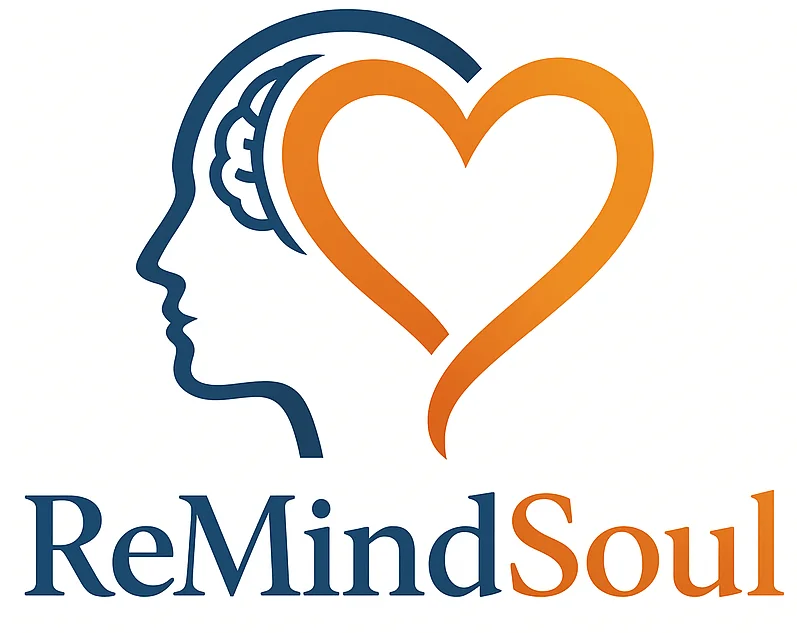Emotional Healing 💔
Restore your Mind, Body & Soul. Learn to process trauma, abuse, and deep emotional wounds. Find peace and transform pain into resilience. Start thriving today!
Emotional Healing: A Complete Guide to Restoring Your Mind, Body, and Soul
Healing is not about erasing pain. It’s about learning to walk with it until it no longer controls your steps.
This guide offers insight into every stage of emotional healing, from trauma, abuse, and pain to spiritual growth and calm restoration. Whether you are navigating loss, recovering from trauma, or carrying wounds you’ve never addressed, this guide will help you find light and the path forward.
What Is Emotional Healing?
Unlike physical wounds, emotional wounds leave invisible scars that can last a lifetime and deeply affect every area of life, from relationships to physical health. Emotional wounds do not disappear with time. Instead, they can manifest as:
- Depression
- Anxiety
- Chronic pain
- Relationship struggles
- Self-destructive patterns
The Science Behind Emotional Pain
Scientific research in psychoneuroimmunology shows that emotions directly influence hormones, the immune system, and brain function. When emotions such as anger, grief, or fear remain unresolved, they create a constant stress response in your body. Over time, this can lead to:
- Fatigue
- Autoimmune issues
- Mood imbalances

The Process of Healing
Emotional healing is the process of acknowledging, processing, and releasing painful emotions stored within your mind and body. It helps you face unhealed parts of yourself with compassion instead of avoidance.
When you begin this journey, you start to understand that emotions are not enemies. They are messages guiding you toward the areas that need care and transformation.
Key Insight: Healing begins when you stop running from your emotions and start listening to what they’re trying to teach you.
Your emotions are not your enemies. They are guides pointing you toward the parts of yourself that still need love.
Importance and Benefits of Emotional Healing
With technology evolving and a fast-paced, achievement-driven society that glorifies productivity and success, many of us carry deep emotional wounds masked by busyness, success, money, and perfectionism. Yet emotional healing is essential because unresolved pain still shapes how we think, feel, and connect with others, often without realizing it.
In a world that celebrates doing, emotional healing invites you to simply be.
The Transformative Power of Healing 🦋
You begin to realize that healing is not the end of your story. It is the rewriting of it.
On a personal level, emotional healing restores your ability to trust yourself. It teaches you to listen to your inner wisdom instead of seeking constant external approval. Through emotional healing, you strengthen your resilience and find the courage to face life’s challenges without losing your sense of self.
Reflection Question: Have you ever noticed how your body feels when you’re overwhelmed or sad? That’s your mind and body asking for attention, not avoidance.
When you ignore your emotions, your body speaks for them. Healing begins when you finally listen.
Core Benefits of Emotional Healing
Personal Growth
- Listen to your inner wisdom and restore your ability to trust yourself.
- Strengthen your resilience to face life’s challenges.
Physical Wellness
- Release stress and tension to improve physical health.
- Support immune system function and reduce chronic symptoms.
Relationship Enhancement
- Enhance relationships through clear boundaries and healthier communication.
- Create space for genuine peace, joy, and authentic connection.
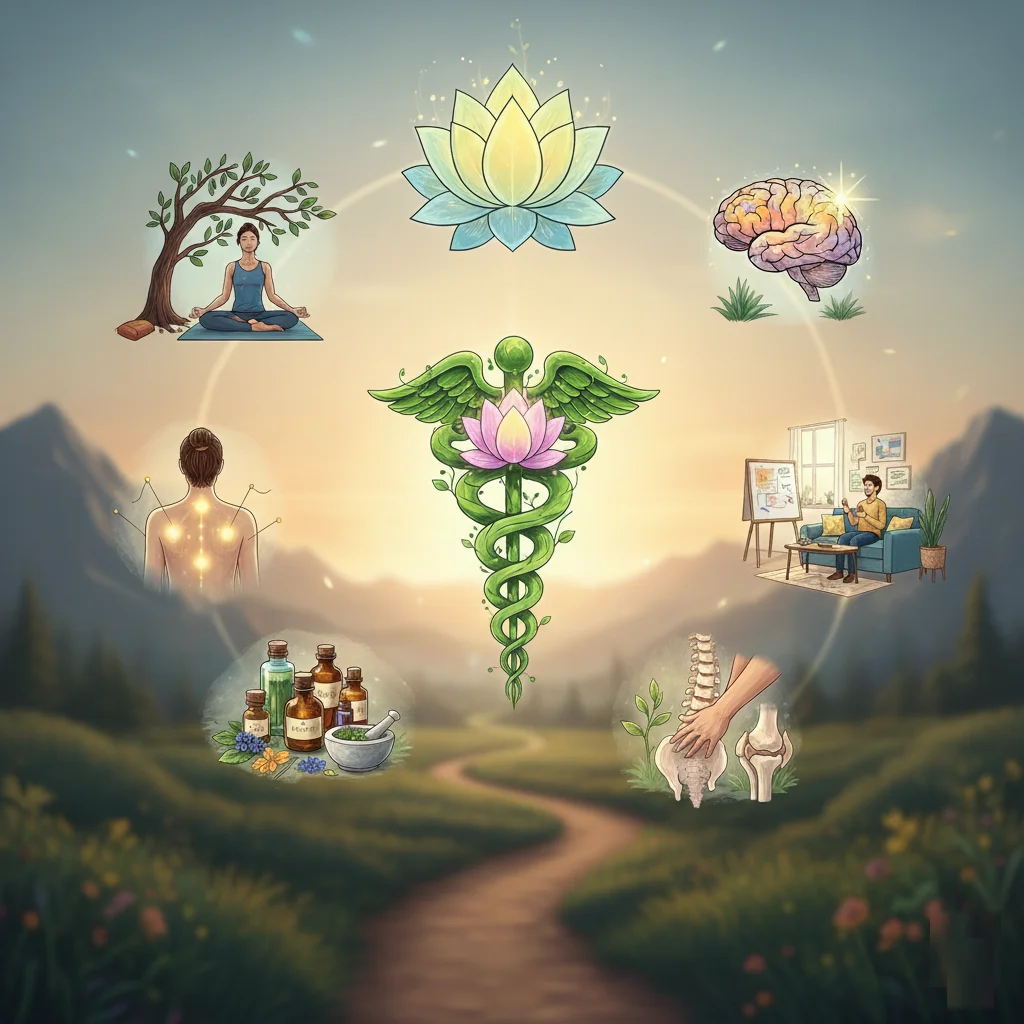
Healing Mentally and Emotionally
The Journey of Transformation
Emotional healing is a deeply personal journey that requires patience, self-compassion, and commitment, but it offers profound rewards: emotional strength, inner peace, and a renewed sense of purpose.
It is a journey of awareness, acceptance, and renewal, connecting your mind, body, and soul.
True healing happens when your mind, body, and soul begin to speak the same language: peace.
Self-Reflection
- What emotions have I been avoiding, and what might they be trying to teach me?
- How does my body react when I hold onto emotional pain?
- In what ways can I show myself compassion today?
- What does “healing” look like for me—not as perfection, but as peace?
- How can I honor my past without letting it define my future?
An Act of Courage
Emotional healing is not a weakness. It is one of the most courageous acts you can undertake.
Through emotional healing, you:
- Reclaim your power and break free from old patterns
- Rebuild your sense of safety
- Create space for genuine joy, love, and connection
- Move from surviving to thriving
- Replace patterns of fear and avoidance with acceptance and self-love
Beyond Psychology: Holistic Wellness
Emotional healing is more than a psychological process. It is essential for full body wellness. The integration of mental, emotional, and physical health creates a foundation for lasting transformation.
Healing doesn’t change your past, but it transforms how your past lives within you.
Key Takeaway
Emotional healing is an act of courage and self-love. By choosing to heal, you honor your pain, embrace personal growth, and create a space for peace to return.
Emotional healing is a sacred choice to honor your pain and make peace with your past.
Emotional Wounds
Human experiences, whether small or large, can leave emotional wounds. The loss of a loved one, illness, abuse, betrayal, or prolonged stress can leave lasting marks on your mind, soul, and body.
Even seemingly minor experiences such as failure, rejection, or harsh criticism can accumulate over time, shaping your emotional patterns and self-image. Recognizing the source of these wounds is important because it helps you understand the root cause rather than just the symptoms.
What Creates Emotional Wounds?
Emotional wounds often stem from experiences that damage your sense of worth, safety, or belonging. Major trauma such as loss, abuse, or emotional neglect can leave invisible scars that affect how you think and relate to others.
Recognizing the cause of your wounds allows you to address them at their root, creating space for lasting recovery.
Healing begins when you acknowledge where you’ve been hurt and allow yourself to feel it.

Types of Emotional Wounds
Relational Wounds
These wounds arise from experiences that break trust and safety in relationships:
- Abandonment or betrayal
- Toxic or abusive relationships
- Rejection or divorce
- Narcissistic manipulation
- Emotional neglect
- Verbal or mental abuse
- Loss of a loved one
They lead to attachment insecurities, distrust, or avoidance. This creates patterns that block emotional vulnerability or closeness.
Healing from these experiences involves addressing emotional neglect, rebuilding trust, and restoring your capacity for genuine connection.
The people who break your heart often reveal the parts of you still waiting to be healed.
Childhood Experiences
Emotional or physical abuse, rejection, neglect, witnessing violence, parental addiction, or growing up in unstable environments can leave deep emotional imprints.
These traumas may show up later as:
- Perfectionism
- Shame
- People-pleasing
- Emotion repression
Many people carry wounds from early environments where emotions were punished, ignored, or dismissed. For example, a child told to “stop crying” learns to suppress feelings rather than express them. Over time, this suppression can create a fear of vulnerability or internalized shame that continues into adulthood.
Healing your inner child means giving yourself the love you once needed.
Societal and Cultural Pressure
Societal expectations about success, gender, or appearance can create emotional wounds, forcing people to hide their authenticity. Constantly striving to meet unrealistic standards leads to inner conflict and the pain of self-rejection.
Healing this wound means reclaiming your right to be genuine, imperfect, and real.
When you stop chasing approval, you make space to meet your true self.
Loss, Grief and Life Transitions
Loss does not only mean death. It includes the loss of:
- Safety
- Identity
- Health
- Relationships
- Dreams
- Self-trust
Miscarriage, divorce, job loss, illness, or major life transitions can leave deep emotional scars. Major life transitions such as serious illness, financial crisis, identity shifts, or unmet expectations can leave emotional scars that affect your mind and soul.
Emotional healing provides healthy ways to process grief rather than numbing or denying it.
Every goodbye holds the seed of a new beginning.
Self-Betrayal and Inner Disconnection
This subtle wound comes from the silencing of your truth or ignoring your inner guidance. Prolonged stress and emotional burnout can keep the body in survival mode, disconnecting you from emotional awareness.
Over time, this emotional disconnect leads to:
- Anxiety
- Fatigue
- Loss of self-trust
Emotional healing helps you rebuild that trust and live in alignment with your deepest values.
Your intuition is the voice of your soul asking to be heard.
Shame, Rejection and Emotional Pain Wounds
Shame is one of the deepest emotional wounds, internalized through emotional neglect, criticism, or conditional love. It tells you that you are not enough, creating self-doubt, isolation, and a fear of rejection.
Unlike guilt, which says “I did something bad,” shame whispers “I am bad.” Rejection wounds often compound shame. Whether it’s being excluded, dismissed, or told you’re “too much” or “not enough,” repeated rejection teaches you to protect yourself by withdrawing or performing. Emotional pain wounds can also stem from:
- Being told your feelings don’t matter
- Having your emotions invalidated or ridiculed
- Learning that vulnerability equals weakness
- Experiencing punishment for expressing needs
Identifying Your Emotional Wounds
Take 5 minutes to reflect on these questions. You can journal your responses or simply sit with them quietly:
- Which type of emotional wound resonates most strongly with you right now?
- When did you first notice this wound affecting your life?
- How does this wound show up in your relationships or daily choices?
- What would it feel like to give yourself permission to heal this part of you?
Remember: Recognizing your wounds is the first step toward healing them. There is no right or wrong answer, only your truth.
Emotional Healing Journey
The emotional healing journey starts in waves, sometimes gentle, sometimes stormy, but always moving you toward greater clarity. Imagine walking through a park after a storm: you notice muddy paths, broken branches, and puddles of water. With every step, you make it through, and as the sunlight begins to break through the clouds, you start to see more clearly. That light is your awareness.
At the beginning of the emotional healing journey, many people feel afraid of facing their emotions or uncertain about what they will uncover. This is completely normal. Our brains are wired to avoid pain and seek safety in what feels familiar. Yet the healing process teaches you that facing your pain does not destroy you; it liberates you.

Emotional and Physical Healing
The emotional healing journey is closely connected to your physical well-being. When emotional pain remains unresolved, it manifests through the body as tension, fatigue, and illness. As you begin to release emotional blockages, your body starts to relaxes, restores balance, and regains energy. Emotional and physical healing work together to create harmony between mind, body, and soul.
When your heart releases its burdens, your body remembers how to breathe again.
Emotional Body Healing
As you move through the emotional healing journey, you begin to notice your emotional triggers losing their intensity. Situations that once felt overwhelming start to feel manageable. This is because your brain begins to re-regulates as emotional energy is released.
Gradually, you experience subtle shifts:
- Deeper breathing
- Better sleep
- More patience
- Unexpected moments of joy
Over time, these small changes accumulate into lasting transformation.
Every step toward self-awareness is a step away from pain and closer to peace.
The Role of Self-Awareness
A key part of the emotional healing journey is self-awareness. It means learning to observe your feelings without judgment. It invites you to pause before reacting and ask, “What is this feeling trying to tell me?” Instead of suppressing emotions, you begin to manage them through self-expression, mindfulness practices, or therapy.
Another important aspect of emotional healing is integration. Healing is not about erasing your past; it is about weaving it into your story in a way that empowers you. Every time you integrate a painful experience, you expand your empathy, emotional intelligence, and self-trust. You begin to realize that your wounds can become your wisdom.
Your body whispers what your heart cannot say. Listen, and it will guide you home.
Self-Awareness Journaling
- “What emotion have You been avoiding lately, and what might it need from me?”
Give yourself permission to write freely for five minutes without editing.
The Important of Emotional Health
The emotional healing journey is not a linear path but more like a spiral. You may revisit certain wounds at a deeper level, and this is a normal part of the process. It is vital to pay attention to emotional health because unresolved emotions influence every area of life, from relationships and work to physical well-being.
With improved emotional health, you gain clarity, strengthen your resilience, and develop the ability to connect with others. It helps you live more mindfully and respond to life’s challenges with understanding rather than delusion and reaction. Emotional health develops the foundation for peace, self-trust, and authentic joy.
Peace begins where emotional awareness meets gentle acceptance.
5 Stages of Emotional Healing
The emotional healing journey follows these stages:
- Recognition — Acknowledging that something within you needs to heal
- Courage — Finding the courage to face what you have been avoiding
- Processing — Working through emotions you may have suppressed for years
- Integration — Embracing the lessons and new perspectives you gain
- Transformation — Becoming a stronger, more resilient version of yourself
It begins with awareness, recognizing that emotional wounds exist and need care. The next stage is acknowledgment, where you face your pain honestly instead of denying it. From there, you enter the stage of release, letting go of guilt, resentment, or shame. Finally, you rebuild, creating new habits, beliefs, and coping mechanisms that support emotional balance.
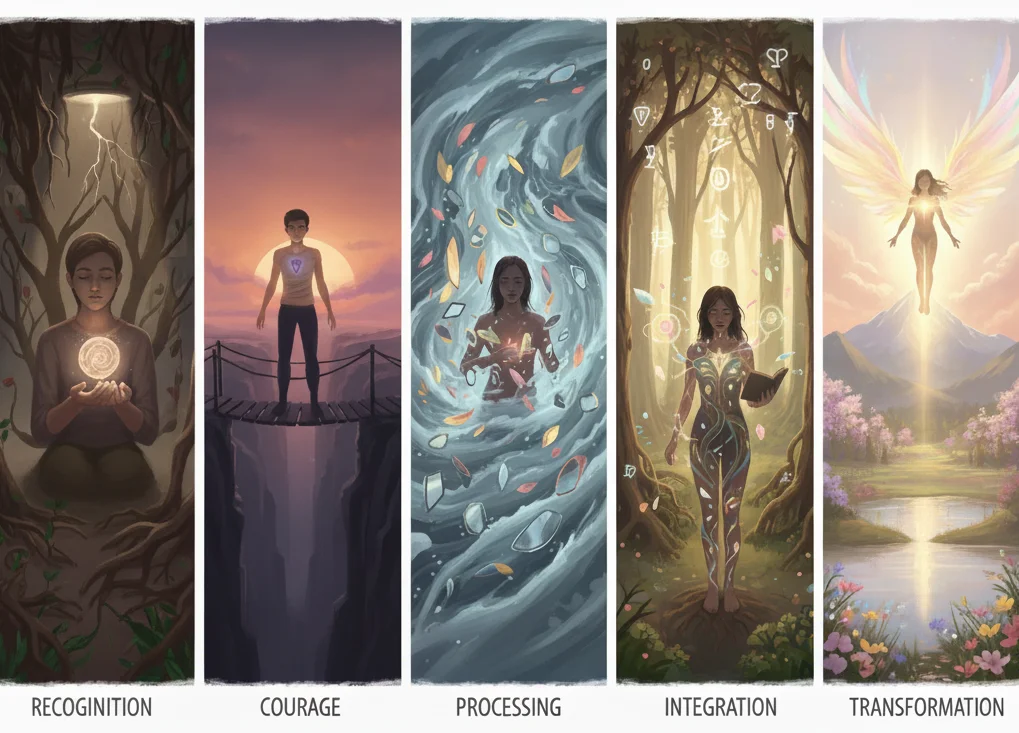
Five-Stage Reflection
Look at the five stages (Recognition, Courage, Processing, Integration, Transformation).
Identify which stage best describes your current place on the journey.
Ask yourself:
- What is helping me move forward?
- What support or tool could help me in the next stage?
The Process of Emotional Healing
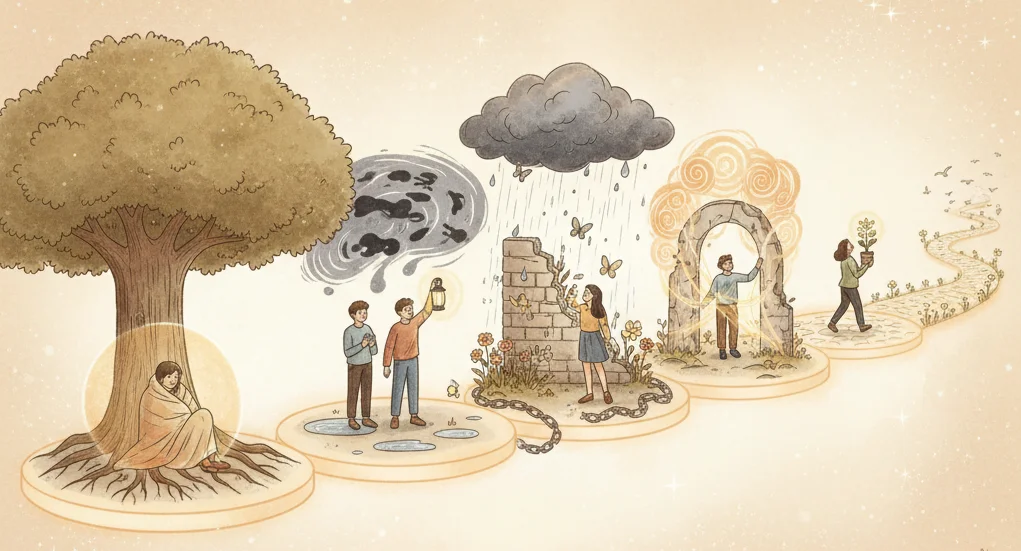
The journey of emotional healing follows a natural progression, guiding you from pain toward peace. Each step builds upon the next, creating a foundation for lasting transformation and emotional wellness.
Step 1: Safety and Stability
The foundation of emotional healing is creating a sense of safety. It involves establishing healthy boundaries, a supportive environment, and grounding practices before exploring wounds. Ensure emotional and physical safety before engaging in any deep healing work. This provides the stability your nervous system and heart need to begin recovery.
“Safety is not the absence of threat, but the presence of connection.” — Dr. Gabor Maté
Step 2: Awareness and Acknowledgment
It is important to bring conscious awareness to emotional wounds and recognize them without judgment. This honest acknowledgment allows the process of emotional healing to begin. When you name your pain, you take the first step toward transforming it.
You cannot heal what you refuse to see. Awareness is the light that starts the journey home.
Step 3: Emotional Processing and Release
The next step is learning to express emotions safely through writing, crying, movement, or therapy. Allow yourself to feel and release emotions in healthy ways rather than suppressing them. This release creates emotional space for peace and paves the way to a renewed version of yourself.
Every tear you release waters the garden of your healing.
Step 4: Reframing and Rebuilding
Healing means changing your mindset and shifting your internal narrative from pain to empowerment. Replace thoughts like “I am broken” with “I am becoming whole.” Let go of resentment, pain, and limiting beliefs through proven techniques.
Healing is not about forgetting the story. It’s about learning to tell it with strength instead of sorrow.
Step 5: Integration
Integration is where healing becomes a lifestyle. It turns new insights into daily practice. Integration is when emotional healing becomes your natural way of being. Apply your emotional tools, awareness, and positive patterns to everyday situations, creating lasting change in how you feel, think, and relate.
Healing becomes real when your new peace shows up in your everyday life.
Healing Techniques for Mind, Body and Soul
Healing Emotional Wounds and Soul Wounds
Healing emotional and soul wounds is a journey of reconnecting with yourself, your inner values, soul, and sense of wholeness. These wounds result from life’s painful moments such as betrayal, loss, abandonment, or emotional neglect. Even subtle experiences, like criticism or rejection, can leave lasting marks on your personality, heart, and mind, shaping how you think, feel, and relate to others.
Over time, these unhealed fragments manifest as self-doubt, emotional numbness, or fear, quietly influencing every part of your life.
When you heal your wounds, you don’t become someone new. You return to who you’ve always been.
The Path to True Healing
True healing begins when you acknowledge your pain. By identifying the pain, you can release the emotional charge and restore inner balance. Healing emotional and soul wounds requires an integrated approach that addresses the mind through mindfulness and reframing negative beliefs, the body through awareness and movement, and the soul through compassion, forgiveness, and connection to something greater.
Through integration, you can reclaim resilience, authenticity, and peace.
Healing Techniques: An Integrated Approach
- Mind-Based Approaches — Cognitive behavioral therapy, journaling, meditation, mindfulness practices, and reframing negative thoughts.
- Body-Based Techniques — Yoga, somatic therapy, breathwork, EFT tapping, body code, and emotional code that release trapped emotions stored in the body.
- Soul-Centered Practices –Prayers, forgiveness work, faith-based counseling, compassion meditation, and connection to God.
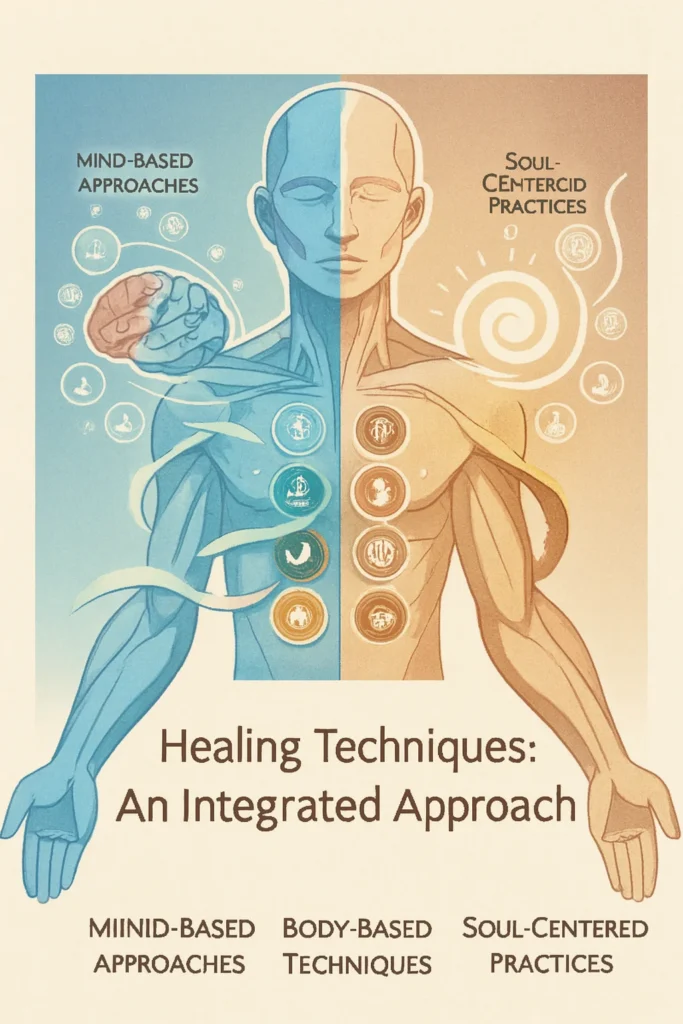
Mind-Based Healing
Your mind is not your enemy; it’s the soil where healing takes root.
Your mind plays a central role in shaping emotional healing outcomes. When limiting beliefs are reprogrammed, healing accelerates.
- Cognitive Behavioral Therapy (CBT) — Reframes distorted thoughts that fuel pain.
- Meditation and Mindfulness — Cultivate emotional neutrality and awareness.
- Journaling and Reflection — Highlight pain points and progress, transforming confusion into clarity.
- Inner Child Work –Rebuilding self-trust and self-acceptance through understanding and compassion.
Body-Centered Healing
Your body holds the stories your heart hasn’t yet told.
Our bodies hold emotional memories, and emotional healing through these techniques allows release beyond talk therapy alone.
- Breathwork — Clears trapped emotional energy and activates calm within the body.
- Body Code and Energy Healing — Address stored emotions causing imbalance.
- Yoga and Movement Therapy — Reconnect you to your body and build resilience.
- Somatic Experiencing — Helps complete the stress response cycle that trauma may have frozen.
Soul-Centered Healing
Healing the soul is remembering that you were never truly broken.
Spiritual practices elevate emotional healing from personal to soul-level transformation. Soul-centered healing involves reconnecting with your spiritual essence and cultivating forgiveness and compassion.
- Faith and Prayer — Anchor you in divine support and trust.
- Forgiveness Work — Release energetic ties to past pain.
- Compassion Meditation — Nurtures empathy and dissolves resentment.
- Energy Healing and Reiki — Rebalance spiritual and emotional energy fields.
Integration: Wholeness Restored
Through the integration of these techniques, emotional healing becomes a spiritual, embodied, and psychological renewal. It unites body, mind, and soul, restoring harmony, clarity, and inner peace.
Healing is not about choosing one path; it’s about weaving every part of yourself back together.
Emotional Healing Exercise
Step 1: Self-Check-In
Take a few deep breaths and ask yourself:
“Where am I feeling emotional pain or imbalance right now?”
Reflect briefly on each area and write a few words for each:
- Mind: (for example, overthinking, self-criticism, confusion)
- Body: (for example, tension, restlessness, fatigue)
- Soul: (for example, sadness, emptiness, disconnection)
Pause for a moment to notice which area feels most in need of care today.
Step 2: Explore and Choose
Read through the techniques below and highlight or underline the ones that resonate most with you — the ones that feel calming, inspiring, or healing right now.
Mind-Based Techniques
- Journaling or reflection
- Meditation or mindfulness
- Reframing negative thoughts
- Inner child work
Body-Based Techniques
- Yoga or gentle stretching
- Breathwork or mindful breathing
- EFT tapping or energy work
- Somatic awareness
Soul-Centered Techniques
- Prayer or faith-based practice
- Forgiveness or compassion work
- Gratitude or connection rituals
- Silent reflection or time in nature
Now, choose one technique from each category that feels most supportive for your current emotional healing needs.
- Mind-Based Choice: ________________
- Body-Based Choice: ________________
- Soul-Centered Choice: ______________
Step 3: Set Your Healing Intention
Using your selected techniques, write a short healing intention statement:
“I choose to heal my (mind/body/soul) through (chosen technique) so I can feel more (desired feeling).”
Examples:
“I choose to heal my mind through journaling so I can feel clear and centered.”
“I choose to heal my body through breathwork so I can feel calm and grounded.”
“I choose to heal my soul through forgiveness so I can feel peaceful and free.”
Take a slow, deep breath and repeat your statement silently.
Visualize yourself practicing these techniques and feeling balanced, strong, and whole.
Beginning Your Healing Journey
Emotional healing is one of the most courageous acts you can undertake. It requires self-compassion, patience, and commitment, but it offers profound rewards — emotional strength, inner peace, and a renewed sense of purpose.
Healing is not about choosing one path; it’s about weaving every part of yourself back together.
Where to Start
- Identify your primary need: Acknowledge and understand your wounds and pain points.
- Choose your entry point: Explore the area or guide that speaks to your current struggle.
- Start with one practice: Begin with a single healing technique or habit.
- Be patient with yourself: Healing unfolds in its own time and rhythm.
Peace begins where emotional awareness meets gentle acceptance.
Explore Healing Dimensions
→ Healing from Trauma and Abuse
Gain insight into recovery from childhood neglect, narcissistic abuse, and emotional wounds caused by toxic relationships.
→ Healing Modalities and Techniques
Discover evidence-based and holistic practices such as the Emotion Code, EFT (Emotional Freedom Techniques), the Body Code, and somatic approaches.
→ Healing Shame, Pain and Emotions
Learn to release toxic shame, resentment, heartbreak, and soul wounds through awareness and compassion.
→ Spiritual Healing
Explore faith-based and biblical approaches to healing through prayer, forgiveness, and compassionate restoration.
→ The Emotional Healing Journey
Understand the stages, steps, and processes that lead to lasting emotional transformation.
You cannot heal what you refuse to feel – but when you do, you reclaim your power, your peace, and your life.
